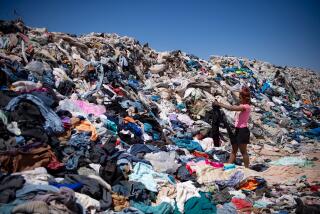Overseas Sale of Donated Clothes
- Share via
Re “Turning Donated Rags Into Riches,” July 28:
The Salvation Army’s Adult Rehabilitation Center program, administered through its western territorial headquarters, is financed solely through the collection and resale of donated items and does not receive cash donations or United Way allocations.
While the Salvation Army does sell a portion of its donated clothing because much of it is unusable, it takes issue with the article that “Although some donors think they are giving their used clothing to the local poor and homeless, very little is ever given to anyone.” In fact, in 1997 to date, the Salvation Army’s adult rehabilitation centers in the western U.S. have donated more than 89,000 pieces of clothing to their program clients.
This figure represents a small portion of the clothing donated to throughout the western U.S., since more than 300 local Salvation Army facilities and more than 700 volunteer-operated units distribute vouchers and cash grants at no charge to assist individuals to acquire clothing and other items from the Salvation Army’s thrift stores and other retail outlets.
Charities by definition are nonprofit organizations and, faced with increasing demands for help, have to be as proactive as possible in seeking revenues to fund their people-helping programs.
ALFRED R. VAN CLEEF
Southern California Divisional Commander
Salvation Army
Los Angeles
Your article implies that there is something unethical or sinister about the fact that some of the used clothing given to charities such as the Goodwill often ends up being sold to dealers who export the garments overseas.
The reality is that some of the goods donated to us simply do not sell. Since Goodwill exists to provided education, training and job placement services to people with disabilities, we have three choices in dealing with this merchandise: send it to the landfill, clearly an unacceptable alternative; give it away to L.A.’s poor and homeless--a worthy cause but not why Goodwill was established; or sell it and use the revenues to expand our programs. This last option seems to us to be the only logical choice.
Goodwill should be lauded, not faulted for carrying out its mission.
DOUGLAS H. BARR
President and CEO Goodwill Industries
The article illuminated a little-known industry. Although the highlighted dealer does seem to have indulged himself a bit, he has done nothing more than find and exploit a good niche. His largess does not seem to extend to his employees: $189 a week after 14 years of employment is not a queenly sum.
PAUL R. COOLEY
Culver City
I am absolutely livid. All this time I have been giving to various organizations to help the poor and needy and instead I am subsidizing the likes of Vahan Chamlian’s $78-million business. I am finding the needy people in my community and giving directly to them.
TRISH ROBERTS
Ontario
Let’s see: 1) I get a charitable-giving tax deduction for giving old clothes to the Salvation Army or Goodwill; 2) those worthy organizations make some money to support their important social services; 3) an enterprising businessman in true American “rags to riches” fashion creates a successful business selling the culls; 4) impoverished Third World countries have a source of clothing.
Do we have a problem here?
RUSS DAVIES
Pacific Palisades
More to Read
Sign up for The Wild
We’ll help you find the best places to hike, bike and run, as well as the perfect silent spots for meditation and yoga.
You may occasionally receive promotional content from the Los Angeles Times.






